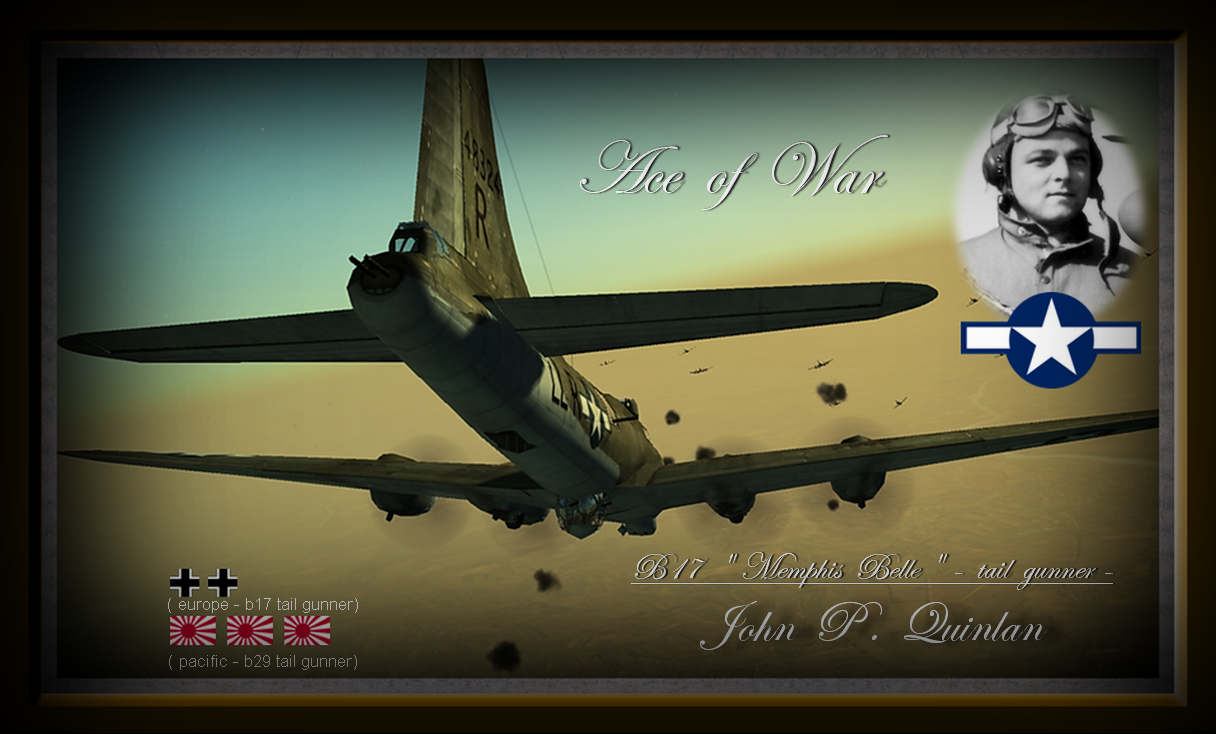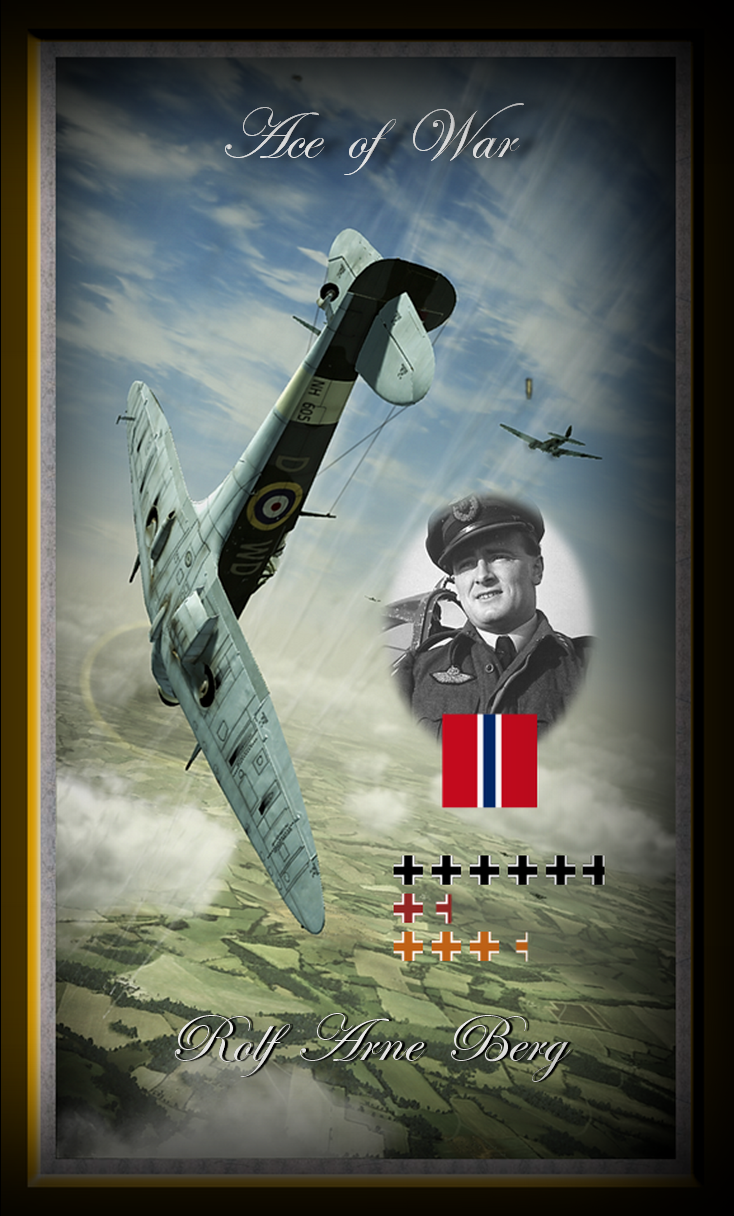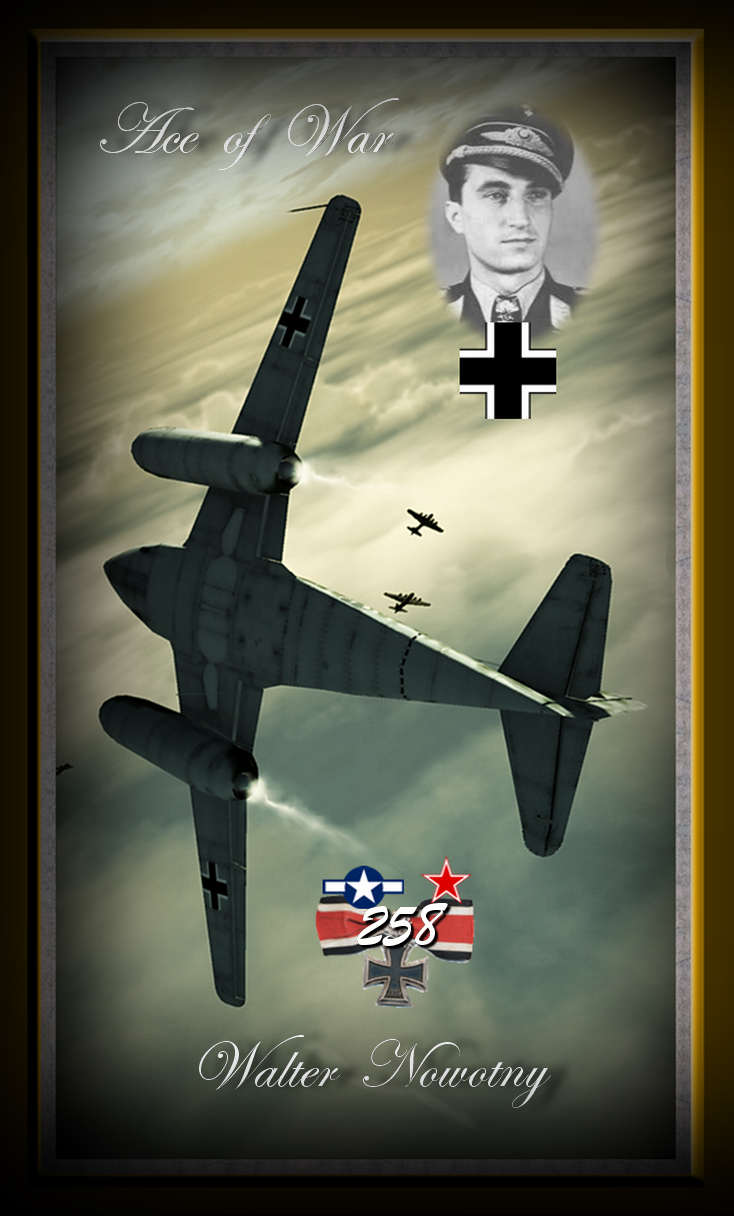
 |
|
|||||||
| IL-2 Sturmovik: Birds of Prey Famous title comes to consoles. |
 |
|
|
Thread Tools | Display Modes |
|
#431
|
|||
|
|||
|
ace of war part 3
[IMG]  [/IMG] [/IMG]John P. Quinlan Rank, Service Tech Sergeant, U.S. Army Air Forces Veteran of: U.S. Army (USAAF) 1942-1945 World War II 1942-1945 Branch Tribute: John Quinlan was born on June 13, 1919, in New York. He enlisted in the U.S. Army Air Forces on April 27, 1942, and after completing basic training, aerial gunnery school, and B-17 Flying Fortress Combat Crew Training, he served as tail gunner on the B-17 "Memphis Belle" with the 324th Bomb Squadron of the 91st Bomb Group in England from September 1942 to May 1943. During this time, Sgt Quinlan was credited with the destruction of 2 enemy aircraft in aerial combat. He and the crew next completed a war bond tour across the United States with the famous B-17 from June to September 1943. After serving in the United States, he began training as a B-29 Superfortress tail gunner, and then deployed to Chakulia AB, India, with the 44th Bomb Squadron of the 40th Bomb Group from April 1944 to February 1945, where he was credited with the destruction of 3 more enemy aircraft in aerial combat, for a total of 5 during World War II. TSgt Quinlan was forced to bail out of his B-29 over China on December 7, 1944, and after returning to his base in India in February 1945, he was sent back to the United States. He received an honorable discharge from the Army Air Forces at the end of the war. John Quinlan died on December 18, 2000, and was buried at the Gerald B.H. Solomon Saratoga National Cemetery in Schuylerville, New York. His wife, Julia A. Quinlan (1923-2003), is buried with him. source:http://www.veterantributes.org/Tribu...il.asp?ID=1289 |
|
#432
|
|||
|
|||
|
ace of war part 4
[IMG]  [/IMG] [/IMG]black crosses=ennemy planes destroyed in aerial combat ,red crosses=ennemy planes probably destroyed in aerial combat ,orange crosses=ennemy planes damaged in aerial combat. Rolf Arne Berg - One of the Few Rolf Arne Berg was probably the best Norwegian fighter pilot during world war two. He might still be the best fighter pilot Norway has ever had. Spitfirepilots.com presents the story of this magnificent fighter pilot, and perhaps even previously unknown information to many about this fascinating man from Norway. The Norwegian pilots during the war spoke seldom about individuals in their group of people. They were all of the same team. Even though, if one individual should be pointed out, it has to be Rolf Arne Berg. Rolf Arne Berg was born in Trøndelag in Norway and joined the air force shortly before the war, and continued his war efforts from England and Europe alongside his fellow pilots in 331 and 332 squadron. Rolf Arne was the kind of person that is very seldom noticed in peace-time. Shy, quiet but extremely intelligent. An expert in handling a Spitfire, maybe the best Norway had. He was an officer but not a snobby one. Rolf Arne was an individual everyone liked, Englishmen and Norwegians all the same. He was an expert at handling dangerous situations. Calm and steady on the stick in most situations normal people would wet themselves in horror. To fly was his life. Once a mission was completed, he was ready for the next. There’s more than a slight possibility that Rolf Arne had more missions than anyone else in the whole 2nd Tactical Air Force. He often talked about what he wanted to do after the war. Sometimes he wanted to continue flying, sometimes he wanted to buy a fishing boat or maybe just travel the world. Fighter pilots were considered as something very glamorous during the war. Glamorous and popular. Almost celebrity like. Some of them were widely known in the media. Rolf Arne however was no big tease among girls as many others were. According to Svein Heglund, Rolf Arne had someone special. Somewhere. One story about Rolf Arne that may not be widely known is the story told in Duncan Smith’s book “Spitfire into battle”. After a mission Smith and Berg landed at an American bomber base in England after running low on fuel. Most of the Americans had never seen a Spitfire up close before and giggled at the site of the small Spitfire compared to their Flying Fortresses. To escort B-17 bombers to Germany had probably never crossed Mitchell’s thought when he designed the wonder that is a Spitfire. The Americans more than willingly filled up their Spitfires with fuel and even wanted to give Rolf Arne and Smith a few dollars as thanks for escorting their bombers into France and back. Rolf Arne, quite embarrassed said: “I’m a Norwegian Officer; I cannot take your money”. The Americans thanked for all the help and waved goodbye to the departing Spitfires on their way back home to North Weald. Rolf Arne stayed with 331 squadron all the way to the end. Promoted to Wing Commander Flying he was the only one in the squadrons with a specially painted Spitfire. His own initials instead of the regular squadron codes. Parts of the tail and the wings were painted in Norwegian flag colours. He had the respect and admiration of both squadrons. Rolf Arne Berg died in February 1945 in a tragic crash. Not only was it so tragic that he died in a crash but he was also tour-expired. He went along for an extra mission out of pure stubbornness and willingness to go up again one more time to fight the enemy. He convinced his friend Zulu Morris to add him to the mission. There had been reports about a Dutch airfield full of German airplanes parked around it. After getting “no” from Helge Mehre, he went further up the command and got his “yes” after all. Even his bags were packed. He was supposed to go to Chamonix to ski. He wasn’t supposed to go over Holland in a Spitfire another time. But, the German airplanes were a too good of a chance to miss. A great opportunity to get in a few easy ground kills. It was supposed to be the encore for Norway’s best overall fighter pilot. Flak was a fighter pilots worst enemy. No experience or 10 German airplanes shot down can help you deal with flak. Flak is about luck. Lots of experienced allied pilots lost their lives to flak when the war in reality had already been won. A German pilot could probably never have gotten close to shooting Rolf Arne down. He was that good and that experienced. Flak was something else. It was game of dice where the looser died. When the Norwegian Spitfires attacked the airfield in Holland the flak opened up on them. Rolf Arne’s Spitfire was hit massively in one of the wings. Probably hit while gaining height after the attack. The Spitfire lost one of its wings and dived without control straight into a barn without exploding. He was found inside the cockpit by locals and buried nearby. It may sound weird that Rolf Arne pulled up after such an attack. Famous fighter pilot Pierre Clostermann writes in his book “The big show” that pulling up from such an attack is asking to be shot down. The flak batteries are able to aim better if you’re higher up and not 10 meters from the ground. Rolf Arne pulled up but he probably had his reasons. There were no real German airplanes on this airfield. They were dummy planes. It makes the entire event even sadder. Rolf Arne Berg, with his capability and experience as leader and as a fighter pilot would have been as good as gold for Norway after the war. The loss of him can still be felt in Norway and the air force. What Rolf Arne would have done for the air force and for his country after the war nobody knows for sure, but it would have been a huge presence from a great man. Norwegian fighter pilots and friends of Rolf Arne visited the church yard were Rolf Arne was buried after the war. On his grave someone had put flowers. Someone cared. Rolf Arne's body was later transferred back to Norway and he's buried in Trøndelag. Rolf Arne Berg – Skvadronleader 331 Skv. 14/5 43 - 1/10 43 DFC Wing Commander Flying 11/3 44 – 3/2 45 Score: 5 ¾ Destroyed 1 ½ Probable, 3 1/3 Damaged Killed 3/2 45 source : http://www.spitfirepilots.com/berg.html a big thanks to Mcq59 for this super link!takk bro! |
|
#433
|
|||
|
|||
|
ace of war part 5
[IMG]  [/IMG] [/IMG]Walter "Nowi" Nowotny Walter “Nowi” Nowotny was born on 7 December 1920 at Ceske Velenice/Gmünd on the Czechoslovakian/Austrian border. He joined the Luftwaffe on 1 October 1939. His flying training was completed at Jagfliegerschule 5 at Schwechat, near Vienna. Nowotny was posted to JG 54 on 23 February 1941. Leutnant Nowotny was assigned to 9./JG 54. His first four weeks with the unit were served with the Stabsschwarm of Ergänzungsgruppe/JG 54. He claimed his first victories over Ösel Island on 19 July, when he shot down two Russian I-153 biplane fighters. However, he was, in turn, shot down in Bf 109 E-7 (W.Nr. 1137) “White 2” by an I-153, flown by the future Russian ace Alexandr Avdeev (13 victories, killed in action 12 August 1942) of 153 IAP, VVS, over Riga Bay in this engagement. After three days and nights at sea in a rubber dinghy, Nowotny finally reached the shore. He recorded his 10th victory on 13 September. On 11 March 1942, Nowotny transferred to 3./JG 54. He shot down five Russian fighters on 20 July. On 2 August 1942, Nowotny claimed seven enemy aircraft shot down to record his 48th through 54th victories. On 11 August, he shot down two Russian MiG-3 fighters. His Bf 109 G-2 (W.Nr. 10 360) was hit in the engagement and caught fire. Nowotny was able to bring the burning aircraft back to his base for a crash-landing, although he did suffer some injuries. Leutnant Nowotny was awarded the Ritterkreuz on 4 September for 56 victories. Nowotny, was appointed Staffelkapitän of 1./JG 54 on 25 October 1942. He recorded his 75th victory on 20 March 1943. On 26 March 1943, Nowotny met the first Russian flown Spitfire fighters, operated by the 26 GvIAP of the Leningrad Air Defence, and shot down one of them for his 79th victory. In June, he shot down 41 enemy aircraft, including five on 1 June (84-8 In September 1944, Major Nowotny was put in charge of Kommando Nowotny, equipped with the Me 262 jet fighter. The unit consolidated a number of test units and was tasked with acquiring tactical knowledge and experience of Me 262 operations. The unit was based on two airfields northwest of Osnabrück: Achmer and Hesepe. Nowotny was besieged with difficulties in operationally testing the jet fighter. In addition to staving off the increasing Allied fighter presence the jets attracted, he was also beset with the technical difficulties a new and immature technology presented. By 7 November 1944, Nowotny had claimed three victories in the new jet fighter. Nowotny took off on 8 November 1944, flying against USAAF bombers with a fighter escort. The exact circumstances of Nowotny’s death remain uncertain. Ground personnel reported hearing combat above the clouds. Nowotny reported he had downed a B-24 four-engine bomber and probably destroyed a P-51 fighter. He then reported an engine failure before making a garbled transmission referring to “burning” over the radio. His Me 262 A-1a (W.Nr. 110 400) “White 8” was seen to dive vertically out of the clouds and crash at Epe, 2.5 kilometres east of Hesepe. It is generally accepted that he was shot down by 1st Lt Edward “Buddy” Haydon of the 357th Fighter Group, USAAF and Capt Ernest “Feeb” Fiebelkorn (9 victories) of the 20th Fighter Group, USAAF whom shared a Me 262 victory at 12:45 over Achmer that day. Walter Nowotny flew over 442 missions in achieving 258 victories. He recorded 255 of his victories over the Eastern front. Of his three victories recorded over the Western front, 2 were four-engine bombers and all 3 victories were gained while flying the Me 262 jet fighter. He claimed 24 victories over Il-2. Victories : 258 Awards : Ehrenpokal (14 July 1942) Deutsches Kreuz in Gold (21 August 1942) Ritterkreuz (4 September 1942) Eichenlaub (4 September 1943) Schwertern (22 September 1943) Brillanten (19 October 1943) Units : JG 54, JG 101, Kdo Nowotny source : http://www.luftwaffe.cz/nowotny.html |
|
#434
|
||||
|
||||
|
Olife friend, occasionally resting lol? Seriously, great job and I encourage it is a pleasure to read these great aces. greetings from your neighbor Spanish
|
|
#435
|
|||
|
|||
|
Quote:
again millions thanks for your very kind words and support!!! hehe...resting!yes , but i like too much plau and work with this game!!!! millions thanks again my spanish neighbour!!!!honored!! friendly olife |
 |
|
|